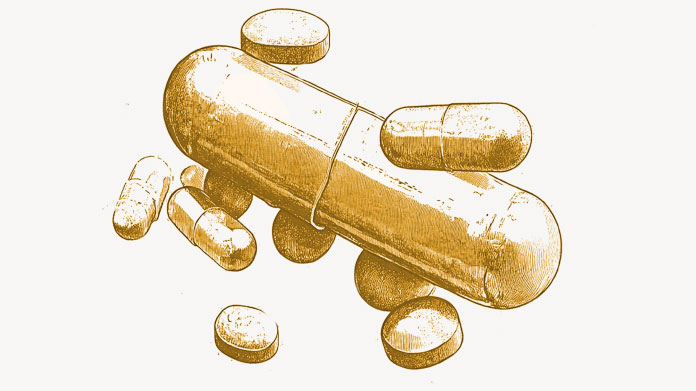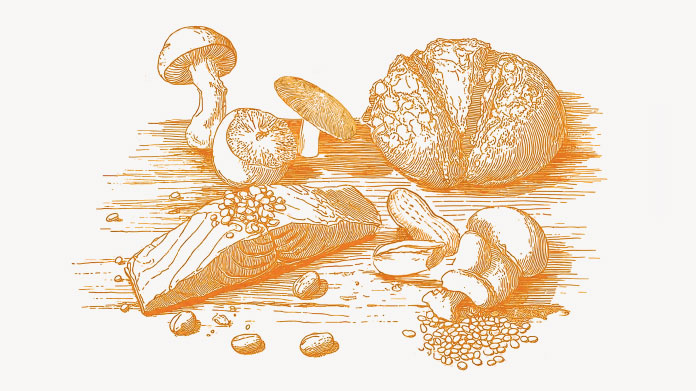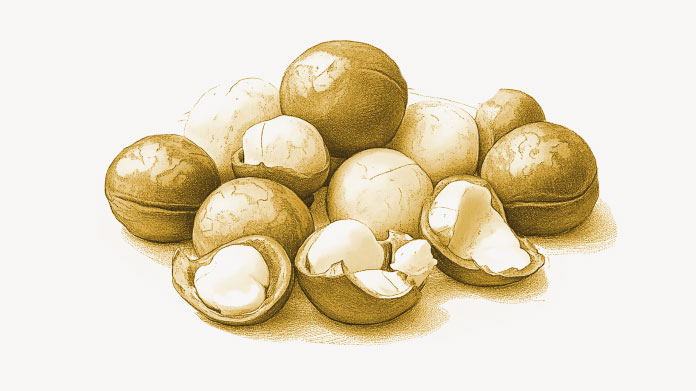Shilajit: benefits and risks of taking ‘mountain tears’
A true concentrate from Nature, shilajit is an extraordinary substance, long-prized by practitioners of Ayurvedic medicine. What are the benefits (and contraindications) of the famous ‘mountain tears’?
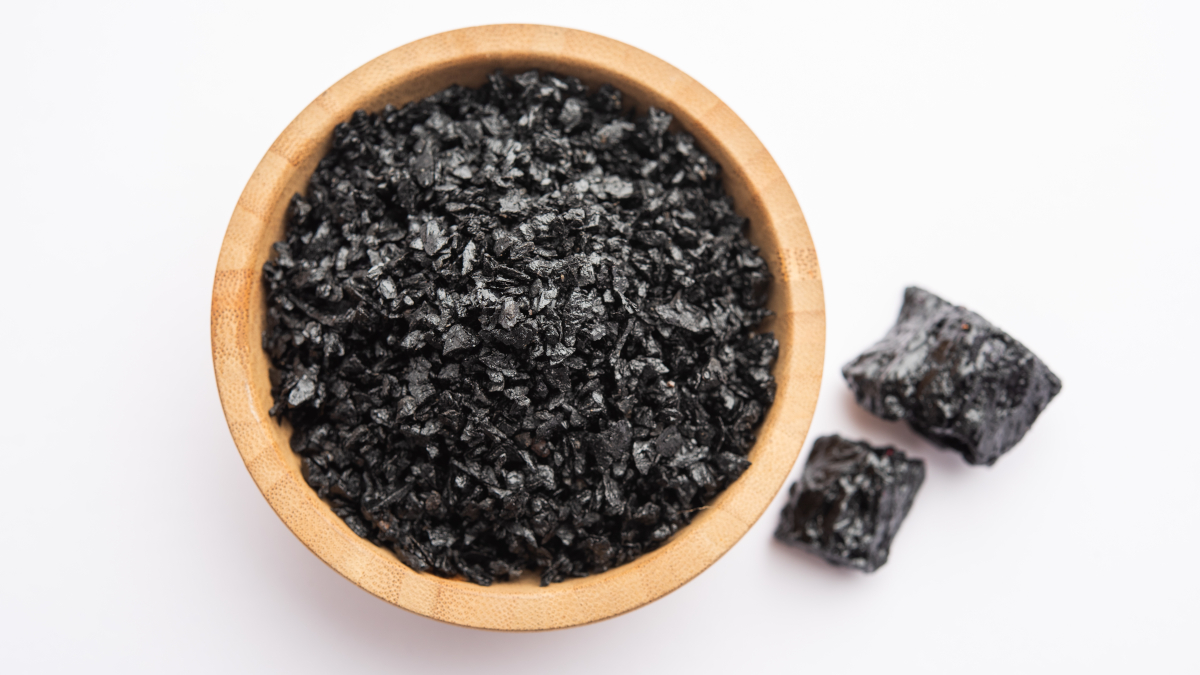
What is shilajit ?
Also known as Mumiyo or black Asphaltum, shilajit (Asphaltum bitumens) is difficult to classify. Neither a true plant nor mineral, it is more accurately described as an exudate, which is secreted under the effects of heat by rocks in high mountain ranges at altitudes of 2000-4000 metres. It is primarily found in the Himalayas, as well as in the Altai, Urals and Caucasus mountain ranges, hence its poetic sobriquet ‘mountain tears’.
It has a tar-like appearance, pale to dark brown in colour, and a unique composition, reflecting the rich physicochemical properties of the sediment from which it comes. It is composed of both humus (the result of plant decomposition), and various organic matter and minerals which have accumulated in the rock over thousands of years in a totally pollution-free environment.
The first written references to mountain tears appear in sacred Sanskrit texts dating back more than 3000 years. Legend has it that it conferred strength and longevity to the large white Himalayan monkeys that would habitually chew it. The local people then decided to benefit from this extraordinary substance themselves, soon noticing positive effects on both mind and body.
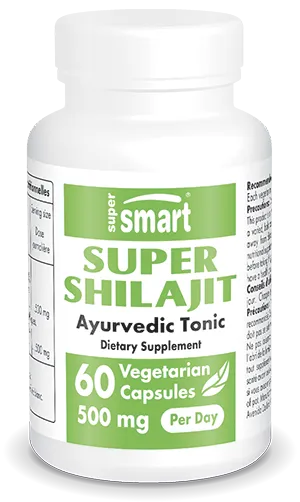
Super Shilajit: guaranteed efficacy and safety
The supplement Super Shilajit is standardized to 60% fulvic acid and 10% DBP-chromoproteins to ensure optimal efficacy. Formulated with purified shilajit to prevent contamination, this patented supplement meets the most stringent safety standards.
Name: Super Shilajit
Dose: for adults. Take 2 capsules a day. Each capsule contains 250mg of PrimaVie™ shilajit extract. Contraindicated in the case of kidney stones.
Contents: 60 gélules végétales.
What benefits does mountain tears offer?
Containing no less than 85 minerals and trace-elements including selenium, shilajit is a powerful phytocomplex from Ayurvedic medicine. It has all the characteristics of a rasayana compound (maintaining youthfulness and energy) (1). Classified as an adaptogen compound, it is valued in particular for its ability to optimise and increase the effects of other plants.
Shilajit helps to support reproductive function, having a particular effect on the mechanisms involved in male spermatogenesis. At the same time, it helps combat menstrual discomfort in women, and can also provide support after the menopause (3).
Mumiyo also helps maintain good mental health by acting at various levels. In India, it is popular for enabling cognitive tasks to be accomplished with optimal efficacy (4). Therapists also recommend it for its soothing and relaxing properties. Rat studies have been conducted to substantiate a probable inhibitory action on certain types of central nervous system neuron (5).
However, its reputation really comes from its regenerative properties. Shilajit’s main component, fulvic acid, acts as a natural scavenger in the body (6). And it’s this humic substance (combined with dibenzo-α-pyrones) to which most of its benefits are attributed.
Research has highlighted fulvic acid’s particular affinity with mitochondria, the ‘powerhouses’ of our cells, responsible for converting glucose into energy (ATP) (7). This helps to explain why shilajit supports the digestion and metabolism of carbohydrates and fats as well as weight control (8-9).
Shilajit also contains many other molecules, present to varying degrees depending on the source, which are likely to contribute to the overall benefits observed: ellagic acid, fatty acids, triterpenes, sterols, polyphenols, phenolic lipids …
Supplementing with shilajit: what are the risks?
Shilajit supplements are generally well-tolerated (10). No drug interactions have been recorded to date.
However, supplementing with mumiyo could, in some cases, lead to an increase in levels of creatinine, a waste-product. As a precaution, therefore, it should not be taken by those suffering from kidney disease or excess uric acid.
As it contains high levels of iron, shilajit is also contraindicated in anyone suffering from hemochromatosis (a genetic condition in which too much iron builds up in the body).
Shilajit in its natural state is likely to contain various impurities such as heavy metals, mycotoxins and polymeric quinones. In order to benefit from its effects in complete safety, it’s therefore essential to supplement with purified forms only (10).
Which shilajit supplement should you choose?
As well as ensuring you take a purified form, there are other criteria to take into account when choosing your shilajit supplement.
Pay close attention to the level of active principles it contains (particularly that of its main active ingredient, fulvic acid), and the manufacturing process used, which should comply with stringent safety standards.
Protected by several US and international patents, the supplement Super Shilajit offers a unique formulation standardised to 60% fulvic acids and 10% DBP-chromoproteins for maximum efficacy.
SUPERSMART ADVICE
References
- Carrasco-Gallardo C, Guzmán L, Maccioni RB. Shilajit: a natural phytocomplex with potential procognitive activity. Int J Alzheimers Dis. 2012;2012:674142. doi: 10.1155/2012/674142. Epub 2012 Feb 23. PMID: 22482077; PMCID: PMC3296184.
- Park JS, Kim GY, Han K. The spermatogenic and ovogenic effects of chronically administered Shilajit to rats. J Ethnopharmacol. 2006 Oct 11;107(3):349-53. doi: 10.1016/j.jep.2006.03.039. Epub 2006 Apr 18. PMID: 16698205.
- Pingali U, Nutalapati C. Shilajit extract reduces oxidative stress, inflammation, and bone loss to dose-dependently preserve bone mineral density in postmenopausal women with osteopenia: A randomized, double-blind, placebo-controlled trial. Phytomedicine. 2022 Oct;105:154334. doi: 10.1016/j.phymed.2022.154334. Epub 2022 Jul 19. PMID: 35933897.
- Carrasco-Gallardo C, Guzmán L, Maccioni RB. Shilajit: a natural phytocomplex with potential procognitive activity. Int J Alzheimers Dis. 2012;2012:674142. doi: 10.1155/2012/674142. Epub 2012 Feb 23. PMID: 22482077; PMCID: PMC3296184.
- Yin H, Yang EJ, Park SJ, Han SK. Glycine- and GABA-mimetic Actions of Shilajit on the Substantia Gelatinosa Neurons of the Trigeminal Subnucleus Caudalis in Mice. Korean J Physiol Pharmacol. 2011 Oct;15(5):285-9. doi: 10.4196/kjpp.2011.15.5.285. Epub 2011 Oct 31. PMID: 22128261; PMCID: PMC3222798.
- Winkler J, Ghosh S. Therapeutic Potential of Fulvic Acid in Chronic Inflammatory Diseases and Diabetes. J Diabetes Res. 2018 Sep 10;2018:5391014. doi: 10.1155/2018/5391014. PMID: 30276216; PMCID: PMC6151376.
- Visser SA. Effect of humic substances on mitochondrial respiration and oxidative phosphorylation. Sci Total Environ. 1987 Apr;62:347-54. doi: 10.1016/0048-9697(87)90521-3. PMID: 2953069.
- Keller JL, Housh TJ, Hill EC, Smith CM, Schmidt RJ, Johnson GO. The effects of Shilajit supplementation on fatigue-induced decreases in muscular strength and serum hydroxyproline levels. J Int Soc Sports Nutr. 2019 Feb 6;16(1):3. doi: 10.1186/s12970-019-0270-2. PMID: 30728074; PMCID: PMC6364418.
- Pattonder RK, Chandola HM, Vyas SN. Clinical efficacy of Shilajatu (Asphaltum) processed with Agnimantha (Clerodendrum phlomidis Linn.) in Sthaulya (obesity). Ayu. 2011 Oct;32(4):526-31. doi: 10.4103/0974-8520.96127. PMID: 22661848; PMCID: PMC3361929.
- Velmurugan C, Vivek B, Wilson E, Bharathi T, Sundaram T. Evaluation of safety profile of black shilajit after 91 days repeated administration in rats. Asian Pac J Trop Biomed. 2012 Mar;2(3):210-4. doi: 10.1016/S2221-1691(12)60043-4. PMID: 23569899; PMCID: PMC3609271.
Keywords
5 Days
Delivery is prompt and I never saw a…
Delivery is prompt and I never saw a quality problem with the manufacturing. It is not possible to assess efficacy on a personal basis, since too many factors come into play. Efficacy can only be assessed statistically with a sufficient number of cases.
Roger De Backer
6 Days
I collaborates with the Supersmart…
I collaborates with the Supersmart more than 10 years. Every thing is going good. Quality of the things is good. Delivery comes in time. Five stars definitely !!!
Oleksiy
6 Days
All good
Simple, frictionless site, easy ordering, good delivery updates and execution.
Chris Robbins
8 Days
I feel better
I feel better
Peter Ammann
8 Days
Prompt delivery
Prompt delivery
JAKUB Radisch
9 Days
My new go-to for top quality supplements!
I am buying more and more of my supplements from this superb, high quality company. Cannot recommend it enough. Plus, excellent customer service with a quick, helpful team and speedy deliveries. Highly recommend Supersmart!
Cecilie H.
13 Days
SUPERSMART WHAT ELSE👍
SUPERSMART WHAT ELSE👍
DIEDERLE Christophe
16 Days
Excellent quality products with…
Excellent quality products with innovative formulas, as someone who has been suffering with acid reflux, these supplements have been lifesavers.
Oriana Moniz
16 Days
high quality supplement!
high quality supplement!
GALANT
16 Days
Good service prompt delivery
Good service prompt delivery
Mrs Marcella Reeves
21 Days
I like your clear explanation
I like your clear explanation. And how to make a choice of products for a specific health problem
Ingrid
28 Days
Great product and it arrives quickly.
Great product and it arrives quickly.
SOMMARIVA Gianni
29 Days
Excellent products and fast service.
Excellent products and fast service. What do we need more?
Margarida
33 Days
The variety of products is amazing
The variety of products is amazing, the offers are good and the sending is very fast. I just miss having a bit more of guidance about combinations, possible interactions, etc.
Maria Angeles Verdu
34 Days
It was quick
It was quick.
Timo Antero


